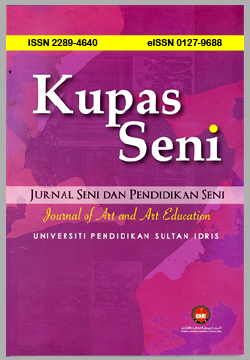Redefining Classroom Pottery: Cement-Based Composites as Eco-Friendly Substitutes for Clay
DOI:
https://doi.org/10.37134/kupasseni.vol12.2.2.2024Keywords:
alternative materials, sustainability, meaningful learning, hands on experiences, cement-based compositesAbstract
This article addresses the challenges in Visual Arts Education (VAE) of acquiring suitable materials for pottery instruction. It investigates the viability of cement-based composites as an alternative to clay in classrooms. The research involved 75 undergraduates and 33 VAE teachers and employed qualitative methods such as interviews, questionnaires, workshops, and field notes to gather and triangulate data. The study identified a significant gap, indicating a deficit in hands on experiences in pottery instruction at secondary education level. Thus, the Creinnomic Media Kit was designed and developed using the Addie Model to bridge this gap and to specifically enhance teachers’ content knowledge and instructional effectiveness in using cement-based composites. Framed within Ausubel’s Meaningful Learning Theory which emphasizes the importance of hands-on learning, the study demonstrated that cement-based composites are practical, versatile and cost effective for pottery instruction. Data analysis, including thematic, document, and content analysis, confirmed the practicality and effectiveness of cement-based composites in pottery instruction. Notably, the composites supported traditional pottery techniques such as casting, pinching, and slab construction, with finished products demonstrating durability and aesthetic qualities comparable to traditional clay pottery, without the need for firing and glazing This research contributes valuable insights into the potential of alternative materials to overcome resource constraints in VAE, promoting meaningful learning and creativity even when traditional materials are unavailable. This research provides essential insights for future advancements in VAE curricula, advocating for the integration of innovative teaching practices that utilize alternative materials to enrich the learning experience and foster student creativity.
Downloads
References
Ausubel, D.P. (2000). The Acquisition and Retention of Knowledge. Dortrecht, Netherlands: Kluwer.
Branch, (2009) Instructional Design: The Addie Approach, 2009 ISBN: 978-0-387-09505-9
Brent, R. (2022). Innovation in the Classroom: Five Characteristics of Successful Classrooms. Education Advanced, Inc https://educationadvanced.com>resources> blog innovation
Daniel S.S., (2021). Smart Materials- Papercrete https://slideshare.net>Design
Drew, C. (January 20, 2023). 31 Major Learning Theories in Education, HelpfulProfessor. https://helpfulprofessor.com/learning-theories/
Dinesh, A., Rubina, I., Asmin Varsha, N., Dhevdharshini, M., Ramesh, C. (2023). Evaluation of the readiness of clay bricks with partially replaced rice husk ash, Materials Today: Proceedings, 2023, ISSN 2214-7853, https://doi.org/10.1016/j.matpr.2023.06.384.
Govella, A. (2020). Workshop Roles & Responsibilities. Retrieved October 22, 2020 from agux.co
Hoffmann, J. D., Ivcevic, Z., & Maliakkal, N. (2021). Emotions, Creativity, and the Arts: Evaluating a Course for Children. Empirical Studies of the Arts, 39(2), 123-148. https://doi.org/10.1177/0276237420907864
Holstermann, N., Grube, D. & Bögeholz, S. (2010). Hands-on Activities and Their Influence on Students’ Interest. Res Sci Educ 40, 743–757 (2010). https://doi.org/10.1007/s11165-009-9142-0
How to Do Thematic Anaysis, (2020). https//delve tool.com>blog>thematicanalysis
Maaruf, S. Z., & Mohamad Helmi, M. N. (2021). Innovating Culturally Responsive Pedagogy with the Craft Fun Kit (CFK). The European Journal of Social & Behavioural Sciences.
Kementerian Pendidikan Malaysia, Bahagian Pembangunan Kurikulum Kementerian Pendidikan Malaysia, Kurikulum Standard Sekolah Menengah, Kementerian Pendidikan Malaysia Putrajaya 2016
Kementerian Pendidikan Malaysia, Kurikulum Standard Sekolah Menengah Pendidikan Seni Visual, Dokumen Standard Kurikulum dan Pentaksiran, Tingkatan 3, Kementerian Pendidikan Malaysia, Putrajaya 2016
Lewis, B. (2020). ‘TML’: Teaching/Learning Materials. “ThoughtCo”, Aug27, 2020, thoughtco.com/tml teaching -learning materials-2081658
Nur Analiza Rahman & Ramlan Mustapha (2020). Effectiveness of Systematic Teaching Methods on Art Creation at the Secondary Level, 1 (1), 2020
Nurul Eza Martu et, al. (2020). Keperluan Kit BSV Sebagai Bahan Bantu Belajar Kepada Murid Murid Di Sekolah Dalam Pembelajaran Pendidikan Seni Visual. JAPPA- Journal of Applied Arts.Vol 2/1 (2020) 121-128.
MOE-Malaysian Education Blueprint (2013-2023). Ministry of Education https://www.moe.gov.my>index.php
Meyer, G. R. (1988). Modules from Design to Implementation, 2nd Ed Filipina: Colombo Plan Staff College for Technical Education pp. 5-6, 19, 22, 46, 49, 63-64, 274, 277, 279, 282-284.
Ponijan, A. et, al. (2019). Visual Arts Education Crisis in Malaysia: Placement of Students into the Arts Curricular Stream at the Upper Secondary Level in Malaysian Schools. Journal of Art & Design, Vol 11/2 2019, 79-92.
Rahmi, K., Rinaldy, S., & Shahrizal, M. (2019). The Effect of Polystyrene on Concrete Mechanical Properties
Radic-Bojanic, B. B., & Pop-Jovanov, D., M. (2018). Workshops in Education: theoretical and practical issues, 9 (9), 223-2
Richey, R. C., & Klein, J. D. (2014). Design and development research: Methods, strategies, and issues. Routledge.
Sandanayake, M., Bouras, Y., Haigh, R., & Vercelj, Z. (2020). Current sustainable trends of using waste materials in concrete—a decade review. Sustainability, 12(22), 9622.
Singh, A., Singla, S., Garg, R. (2020). Performance analysis of Papercrete in presence of Rice husk ash and Fly ash. In IOP Conference Series: Materials Science and Engineering (Vol. 961, No.1, p 012010). IOP Publishing
Shinde, A et al., (2023). Effective Use of Papercrete. International Research Journal of Modernization in Engineering Technology and Science. Volume:05/Issue:04/April-2023
Siti Zuraida Maaruf & Nabilah Abdullah, (2020). Sustaining Local Heritage: Fibre Art as a New Paradigm to Uplift Malaysian Craft Production. Article in Malaysian Journal of Sustainable Environment.
Solahuddin, B. A., & Yahaya F., M (2022). Properties of concrete containing shredded waste paper as an additive, Materials Today: Proceedings, Volume 51, Part 2, 2022, Pages 1350-1354, ISSN 2214-7853, https://doi.org/10.1016/j.matpr.2021.11.390.
Downloads
Published
Issue
Section
License
Copyright (c) 2024 Sailaja Ramachandran, Nor Syazwani Mat Salleh, Azlin Iryani Mohd Noor

This work is licensed under a Creative Commons Attribution-NonCommercial-ShareAlike 4.0 International License.





